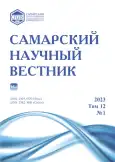Mycobiota of the rhizosphere of vegetable and flower-ornamental crops in the conditions of Surgut
- Authors: Mantrova M.V.1
-
Affiliations:
- Surgut State University
- Issue: Vol 12, No 1 (2023)
- Pages: 76-81
- Section: Biological Sciences
- URL: https://journals.rcsi.science/2309-4370/article/view/133946
- DOI: https://doi.org/10.55355/snv2023121111
- ID: 133946
Cite item
Full Text
Abstract
The paper presents the results of a study of the mycobiota of the control soil and the rhizosphere of 11 vegetable and 6 flower-ornamental plant species. Flower cultures are represented by Gauston ageratum, double-feathered cosmea, erect marigolds and thin-leaved marigolds, hybrid petunia and brilliant sage. Closed-ground vegetable crops are cucumber, tomato, hot pepper and Bulgarian pepper; open-ground vegetable crops are seed peas, radish, garlic, potatoes, sorrel, dill and curly parsley. During the year of the research, fertilizers were not introduced into the soil. Most vegetable crops were grown continuously for several years, flower crops – during the year. In the mycocoenoses of the rhizosphere of most vegetable crops, toxin-forming species of the genus Penicillium are abundant: P. citrinum, P. citreonigrum and P. polonicum. The toxin-forming agent P. citrinum was found in the mycobiota of the control soil and the rhizosphere of most vegetable and flower-ornamental crops. In the structure of the mycobiota of the control soil, mycocoenoses of the rhizosphere of some vegetable crops such as seed peas, curly parsley, Bulgarian pepper and in the mycobiota of the rhizosphere of flower-ornamental crops, saprotrophic micromycetes with a noticeable abundance of cosmopolite Aspergillus phoenicis (from the A. niger group) are abundant in mycocoenoses of the rhizosphere of the double-feathered cosmea, hybrid petunia, marigolds erect and Bulgarian pepper. According to the research results, it can be concluded that the formation of the species composition of the mycobiota of the rhizosphere of vegetable and flower-ornamental crops is influenced by the type of plant, conditions and duration of cultivation. In the future the author is going to study the species composition of the mycobiota of the rhizosphere depending on the duration of plant cultivation, the expansion of their assortment, as well as the effect of fertilizers on the species composition of the soil mycobiota.
Full Text
##article.viewOnOriginalSite##About the authors
Maria Viktorovna Mantrova
Surgut State University
Author for correspondence.
Email: mantrova-mariya@yandex.ru
junior researcher of Scientific and Educational Center of Institute of Natural and Technical Sciences
Russian Federation, Surgut, Khanty-Mansi Autonomous Okrug – YugraReferences
- Мирчинк Т.Г. Почвенная микология: учебник. М.: Изд-во МГУ, 1988. 220 с.
- Марфенина О.Е. Антропогенная экология почвенных грибов. М.: Медицина для всех, 2005. 196 с.
- Микромицеты почв / под общ. ред. В.И. Билай. Киев: Наук. думка, 1984. 264 с.
- Шепелева Л.Ф., Шепелев А.И., Самойленко З.А., Мазитов Р.Г. Почвы и растительность центральной части таежной зоны Западной Сибири (в пределах Ханты-Мансийского автономного округа): учеб. пособие. Сургут: ИЦ СурГУ, 2010. 104 с.
- Атлас Ханты-Мансийского автономного округа – Югры. Т. II. Природа и экология / отв. ред. В.А. Дикунец, Т.В. Котова, В.Н. Макеев, В.С. Тикунов. Ханты-Мансийск; М.: Роскартография; Мониторинг, 2004. 152 с.
- Мамедов Т.А. Микроорганизмы как фактор токсичности почв при бессменном выращивании овощных культур: дис. … канд. биол. наук: 03.00.07. Л., 1984. 173 с.
- Шамин А.А. Формирование комплекса почвенной и ризосферной фитопатогенной микобиоты в агроценозе сахарной свёклы ЦЧР: автореф. дис. … канд. с/х. наук: 06.01.07. М., 2015. 23 с.
- Великанов Л.Л., Сидорова И.И., Успенская Г.Д. Полевая практика по экологии грибов и лишайников. М.: Изд-во Московского ун-та, 1980. 112 с.
- Руководство к практическим занятиям по микробиологии: учеб. пособие / под ред. Н.С. Егорова. М.: Изд-во МГУ, 1995. 224 с.
- Зенова Г.М., Степанов А.Л., Лихачева А.А., Манучарова Н.А. Практикум по биологии почв: учеб. пособие. М.: Изд-во МГУ, 2002. 120 с.
- Литвинов М.А. Определитель микроскопических почвенных грибов. Л.: Наука. Ленингр. отд., 1967. 302 с.
- Domsch K.H., Gams W., Anderson T.-H. Compendium of soil Fungi. Munchen: IHV-VerlagEching, 2007. 672 p.
- Boerema G.H., de Gruyter J., Noordeloos M.E., Hamers M.E.C. Phoma identification manual. Differentiation of specific and infra-specific taxa in culture. Cambridge: CABI Publishing, 2004. 470 p. doi: 10.1079/9780851997438.0000.
- Food and indoor fungi / R.A. Samson, J. Houbraken, U. Thrane, J.C. Frisvad, B. Andersen. Utrecht: CBS-KNAW Fungal Biodiversity Centre, 2010. 390 p.
- Александрова А.В., Великанов Л.Л., Сидорова И.И. Ключ для определения видов рода Trichoderma // Микология и фитопатология. 2006. Т. 40, вып. 6. С. 457–468.
- Билай В.И., Коваль Э.З. Аспергиллы. Киев: Наук. думка, 1988. 204 с.
- Кириленко Т.С. Определитель почвенных сумчатых грибов. Киев: Наук. думка, 1978. 264 с.
- Саттон Д., Фотергилл А., Ринальди М. Определитель патогенных и условно патогенных грибов / пер. с англ. К.Л. Тарасова, Ю.Н. Ковалева. М.: Мир, 2001. 468 с.
- Guarro J., Gene J., Stchigel A.M., Figueras M.J. Atlas of soil ascomycetes. Iss. 10. CBS Biodiversity Series. Utrecht: CBS-KNAW Fungal Biodiversity Center, 2012. 486 p.
- Алимова Ф.К. Промышленное применение грибов рода Trichoderma. Казань: Казанский государственный университет им. В.И. Ульянова-Ленина, 2006. 209 с.
- Тутельян В.А., Кравченко Л.В. Микотоксины (медицинские и биологические аспекты). М.: Медицина, 1985. 320 с.
- Кузнецов А.Ф. Ветеринарная микология: учеб. пособие. М.: Юрайт, 2020. 345 с.
- Берестецкий О.А., Боровков А.В. Фитотоксические метаболиты почвенных пенициллиев // Микробиологический журнал. 1979. Т. 41, вып. 3. С. 291–302.
Supplementary files







